Harris C.M., Piersol A.G. Harris Shock and vibration handbook
Подождите немного. Документ загружается.


RELATIONSHIP BETWEEN D
0
, D
a
, AND D
If the specific damping energy is integrated throughout the stressed volume,
D
0
=
V
0
0
D dV (36.4)
This is a triple integral; dV = dx dy dz and D is regarded as a function of the space
coordinates x, y, z. If there is only one nonzero stress component, the specific damp-
ing energy D may be considered a function of the stress level σ. Then
D
0
=
σ
d
0
D dσ (36.5)
In this integration, V is the volume of material whose stress level is less than σ.The
integration is a single integral, and σ
d
is the peak stress. The integrands may be put
in dimensionless form by introducing D
d
, the specific damping energy associated
with the peak stress level reached anywhere in the specimen during the vibration
(i.e., the value of D corresponding to σ=σ
d
). Then
D
0
= D
d
V
0
α (36.6)
where α=
1
0
d
(36.7)
The average damping energy is
D
a
==D
d
α (36.8)
The relationship between the damping energies D
0
, D
a
, and D depends upon the
dimensionless damping energy integral α. The integrand of α may be separated into
two parts: (1) a damping function D/D
d
which is a property of the material and (2) a
volume-stress function d(V/V
0
)
/
d(σ/σ
d
) which depends on the shape of the part and
the stress distribution.
RELATIONSHIP BETWEEN SPECIFIC DAMPING ENERGY
AND STRESS LEVEL
Before the damping function D/D
d
can be determined, the specific damping energy
D must be related to the stress level σ. Data of this type for typical engineering
materials are given in Figs. 36.10 and 36.11. These results illustrate the fact that the
damping-stress relationship for all materials cannot be expressed by one simple
function. For a large number of structural materials in the low-intermediate stress
region (up to 70 percent of σ
e
the fatigue strength at 2 × 10
7
cycles), the following
relationship is reasonably satisfactory:
D = J
n
(36.9)
Values of the constants J and n are given in Table 36.5 and Fig. 36.10. In general,
n = 2.0 to 3.0 in the low-intermediate stress region but may be much larger at high
stress levels. Where Eq. (36.9) is not applicable, as in the high stress regions of Figs.
σ
σ
e
D
0
V
0
σ
σ
d
d(V/V
0
)
d(σ/σ
d
)
D
D
d
dV
dσ
MATERIAL DAMPING AND SLIP DAMPING 36.7
8434_Harris_36_b.qxd 09/20/2001 12:28 PM Page 36.7
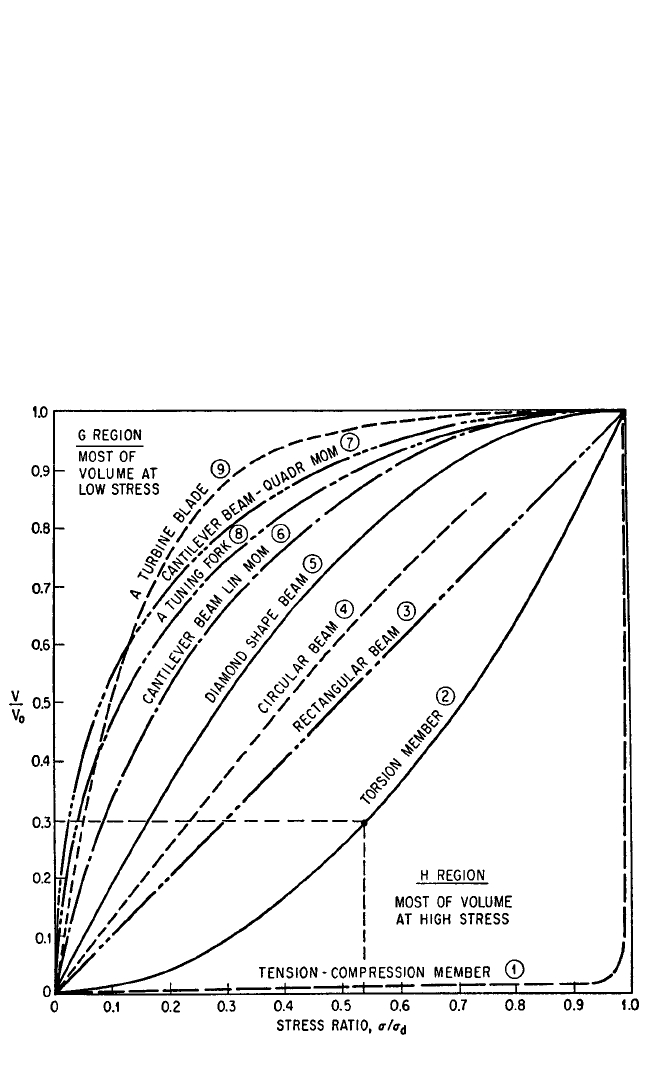
36.10 and 36.11 or in the case of the 403 steel alloy of Fig. 36.9, analytical expressions
are impractical and a graphical approach is more suitable for the computation of α.
VOLUME-STRESS FUNCTION
The volume-stress function (V/V
0
) may be visualized by referring to the dimension-
less volume-stress curves shown in Fig. 36.5. The variety of specimen types included
in this figure [tension-compression member (1) to turbine blade (9)] is representa-
tive of those encountered in practice. These curves give the fraction of the total vol-
ume which is stressed below a certain fraction of the peak stress. In a torsion
member, for example, 30 percent of the material is at a stress lower than 53 percent
of the peak stress. The volume-stress curves for a part having a reasonably uniform
stress, i.e., having most of its volume stressed near the maximum stress, are in the
region of this diagram labeled H. By contrast, curves for parts having a large stress
36.8 CHAPTER THIRTY-SIX
FIGURE 36.5 Volume-stress functions for various types of parts. (See Table 36.1 for additional
details on parts.)
8434_Harris_36_b.qxd 09/20/2001 12:28 PM Page 36.8
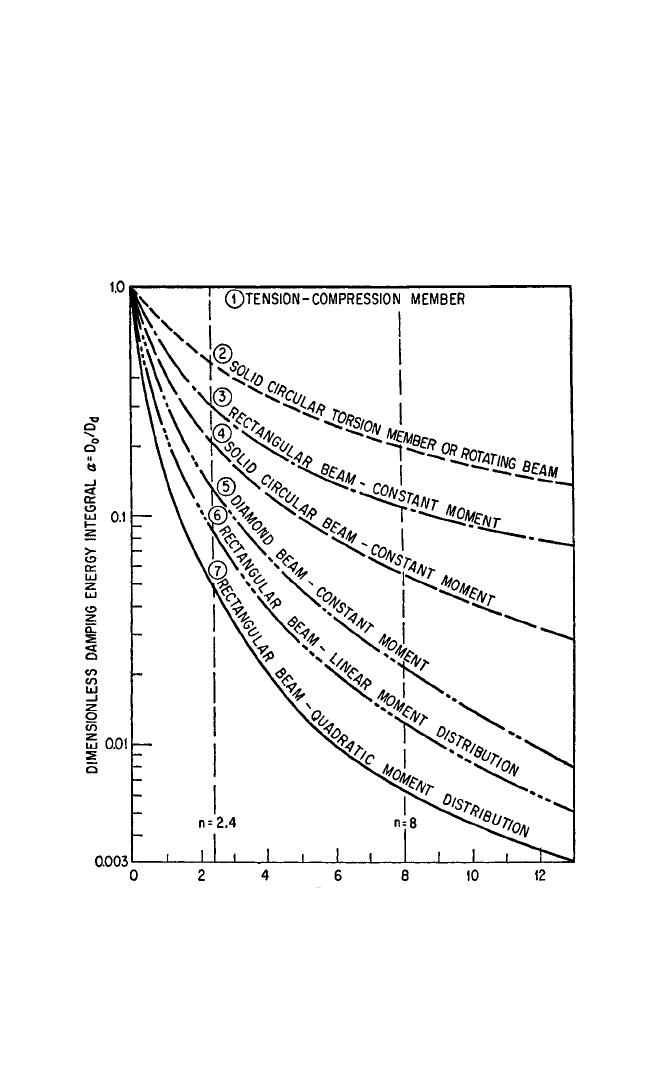
gradient (such as a notched beam in which very little volume is at the maximum
stress and practically all of the volume is at a very low stress) are in the G region.
In order to illustrate representative values of α for several cases of engineering
interest, the results of selected analytical and graphical computations
11
are summa-
rized in Table 36.1 and in Fig. 36.6. In Fig. 36.6 the effect of the damping exponent n
on the value of α for different types of representative specimens is illustrated. Note
the wide range of α encountered for n = 2.4 (representative of many materials at low
and intermediate stress) and for n = 8 (representative of materials at high stress, as
shown in the next section).
RATIO OF DAMPING ENERGY TO STRAIN ENERGY
Owing to the complexity of the sources of material damping, the use of relative
damping energy units does not produce all the advantages that might otherwise be
associated with a nondimensional quantity. One motivation for the use of such units,
however, is their direct relation to several conventional damping tests. The logarith-
MATERIAL DAMPING AND SLIP DAMPING 36.9
FIGURE 36.6 Damping exponent n in equation D = J(σ/σ
e
)
n
.
8434_Harris_36_b.qxd 09/20/2001 12:28 PM Page 36.9
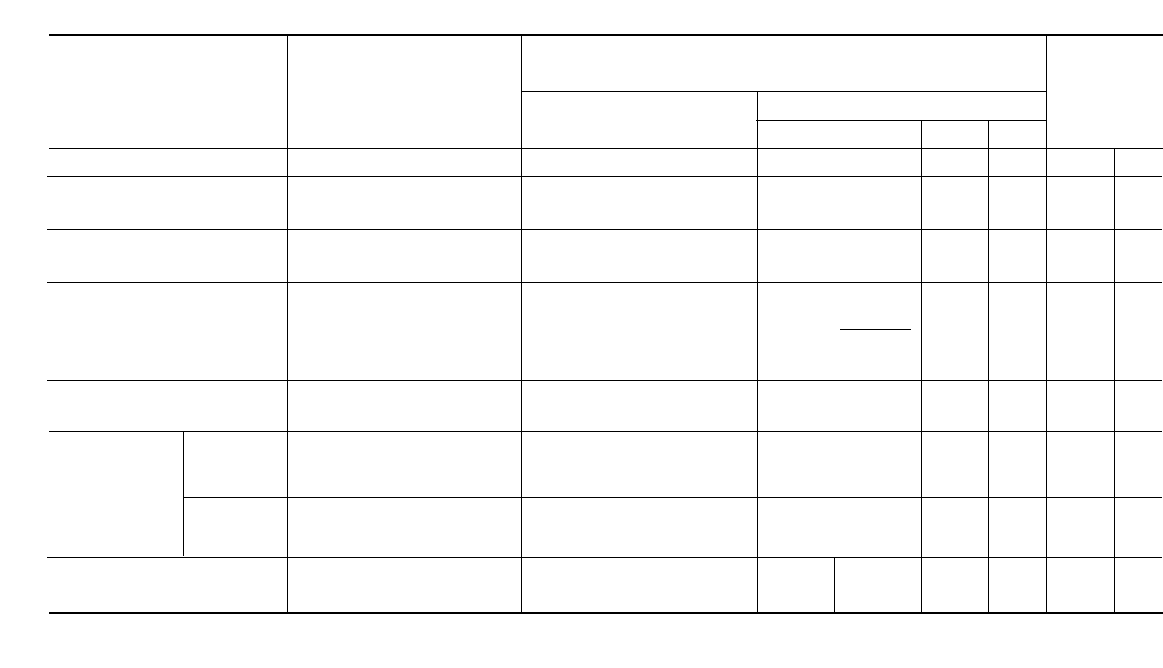
36.10
TABLE 36.1 Expressions and Values for α and β/α for Various Stress Distribution and Damping Functions
Dimensionless damping energy integral α
Dimen-
for various damping functions
sionless
strain
energy β/α
Type of specimen and loading Volume-stress function
For special case D = J(σ/σ
e
)
n
integral if
as designated in Fig. 36.1 V/V
0
General case D = f(σ) For any value of nn= 2.4 n = 8 β n = 8
1 Tension-compression member 1 1 1 1 1.0 1
2 Cylindrical torsion member or
2
1 +
−1
0.45 0.20 0.5 2.5
rotating beam
3 Rectangular beam under uniform
1 +
−1
0.29 0.11 0.33 3.0
bending
4 Cylindrical beam under uniform
1 −
2
+ sin
−1
0.21 0.055 0.24 4.5
bending
5 Diamond beam under uniform
2 −
2
1 ++
−1
0.13 0.022 0.17 7.7
bending
6
Rectangular beam
M
x
= M
0
1 − log
e
1 ++
−1
0.088 0.012 0.11 9.1
having bending
moment shown
7 M
x
=
2
M
0
2
−
1 ++
−1
0.051 0.0065 0.067 10.0
8 Tuning fork in bending K
1 − log
e
K
1 ++
−1
→ 0.091 0.0099 0.089 9.0
Note: β/α=1 for all cases if n = 2.
For
K = 0.8
K
(n + 1)
2
d
2
D
0
dσ
d
2
σ
d
2
D
0
dD
0
dσ
d
3σ
d
D
0
σ
σ
d
σ
σ
d
1
2n
2
+ 3n + 1
d
2
D
0
dσ
d
2
2σ
d
2
D
0
dD
0
dσ
d
5σ
d
D
0
σ
σ
d
σ
σ
d
x
L
1
(n + 1)
2
d
2
D
0
dσ
d
2
σ
d
2
D
0
dD
0
dσ
d
3σ
d
D
0
σ
σ
d
σ
σ
d
x
L
2
n
2
+ 3n + 2
d
2
D
0
dσ
d
2
σ
d
2
2D
0
dD
0
dσ
d
2σ
d
D
0
σ
σ
d
σ
σ
d
2
n + 2
1
π
σ
σ
d
σ
σ
d
σ
σ
d
2
π
1
n + 1
dD
0
dσ
d
σ
d
D
0
σ
σ
d
2
n + 2
dD
0
dσ
d
σ
d
2D
0
σ
σ
d
Γ
Γ
n + 2
2
n + 1
2
8434_Harris_36_b.qxd 09/20/2001 12:28 PM Page 36.10

mic decrement ∆ is defined by Eq. (36.2). Other energy ratio units are tabulated and
defined below. In this chapter, the energy ratio unit termed loss factor is used as the
reference unit.
In defining the various energy ratio units, it is important to distinguish between
loss factor η
s
of a specimen or part (having a variable stress distribution) and the loss
factor η for a material (having a uniform stress distribution). By definition the loss
factor of a specimen (identified by subscript s) is
η
s
= (36.10)
where the total damping D
0
in the specimen is given by Eq. (36.6). The total strain
energy in the part is of the form
W
0
=
V
0
0
dV =
V
0
β (36.11)
where E denotes a modulus of elasticity and β is a dimensionless integral whose
value depends upon the volume-stress function and the stress distribution:
β=
1
0
2
d
(36.12)
On substituting Eq. (36.6) and Eq. (36.11) in Eq. (36.10), it follows that
η
s
= (36.13)
If the specimen has a uniform stress distribution, α=β=1 and the specimen loss fac-
tor η
s
becomes the material loss factor η; in general, however,
η= =η
s
(36.14)
Other energy ratio (or relative energy) damping units in common use are defined
below:
For specimens with variable stress distribution:
η
s
= (tan φ)
s
===
s
===
(36.15)
For materials or specimens with uniform stress distribution:
η=tan φ= = = = = =Q
−1
= (36.16)
where η=loss factor of material = dissipation factor (high loss factor signi-
fies high damping)
tan φ=loss angle, where φ is phase angle by which strain lags stress in
sinusoidal loading
ψ=πη=specific damping capacity
δω/ω
n
= (bandwidth at half-power point)/(natural frequency) [see Eq.
(36.3)]
A
r
= resonance amplification factor [see Eq. (36.1)]
ED
d
πσ
d
2
1
Q
1
A
r
δω
ω
n
ψ
π
∆
π
α
β
ED
d
πσ
d
2
1
Q
s
1
(A
r
)
s
δω
ω
n
ψ
s
π
∆
s
π
β
α
ED
d
πσ
d
2
α
β
D
d
σ
d
2
E
π
σ
σ
d
d(V/V
0
)
d(σ/σ
d
)
σ
σ
d
σ
d
2
E
1
2
σ
2
E
1
2
D
0
2πW
0
MATERIAL DAMPING AND SLIP DAMPING 36.11
8434_Harris_36_b.qxd 09/20/2001 12:28 PM Page 36.11
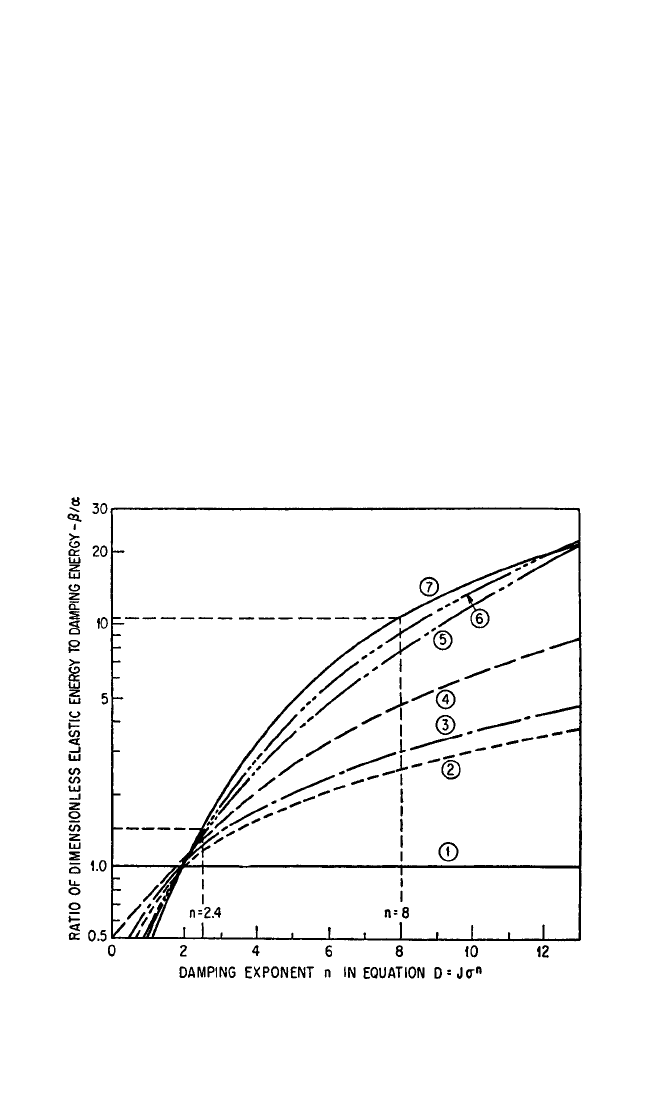
Q = 1/η=measure of the sharpness of a resonance peak and amplification
produced by resonance
The material properties are related to the specimen properties as follows:
ψ=ψ
s
∆=∆
s
A
r
= (A
r
)
s
(36.17)
Thus, the various energy ratio units, as conventionally expressed for specimens,
depend not only on the basic material properties D and E but also on β/α. The ratio
β/α depends on the form of the damping-stress function and the stress distribution in
the specimen.As in the case of average damping energy, D
a
, the loss factor or the log-
arithmic decrement for specimens made from exactly the same material and exposed
to the same stress range, frequency, temperature, and other test variables may vary
significantly if the shape and stress distribution of the specimen are varied. Since data
expressed as logarithmic decrement and similar energy ratio units reported in the
technical literature have been obtained on a variety of specimen types and stress dis-
tributions, any comparison of such data must be considered carefully. The ratio β/α
may vary for specimens of exactly the same shape if made from materials having dif-
ferent damping-stress functions. For different specimens made of exactly the same
materials, the variation in β/α also may be large, as shown in Fig. 36.7. For example,
α
β
β
α
β
α
36.12 CHAPTER THIRTY-SIX
FIGURE 36.7 Effect of damping exponent n on ratio β/α for D = Jσ
n
. Curves
are (1) tension-compression member; (2) solid circular torsion member or rotat-
ing beam; (3) rectangular beam–constant moment; (4) solid circular beam–con-
stant moment; (5) diamond beam–constant moment; (6) rectangular beam–linear
moment distribution; and (7) rectangular beam–quadratic moment distribution.
8434_Harris_36_b.qxd 09/20/2001 12:28 PM Page 36.12
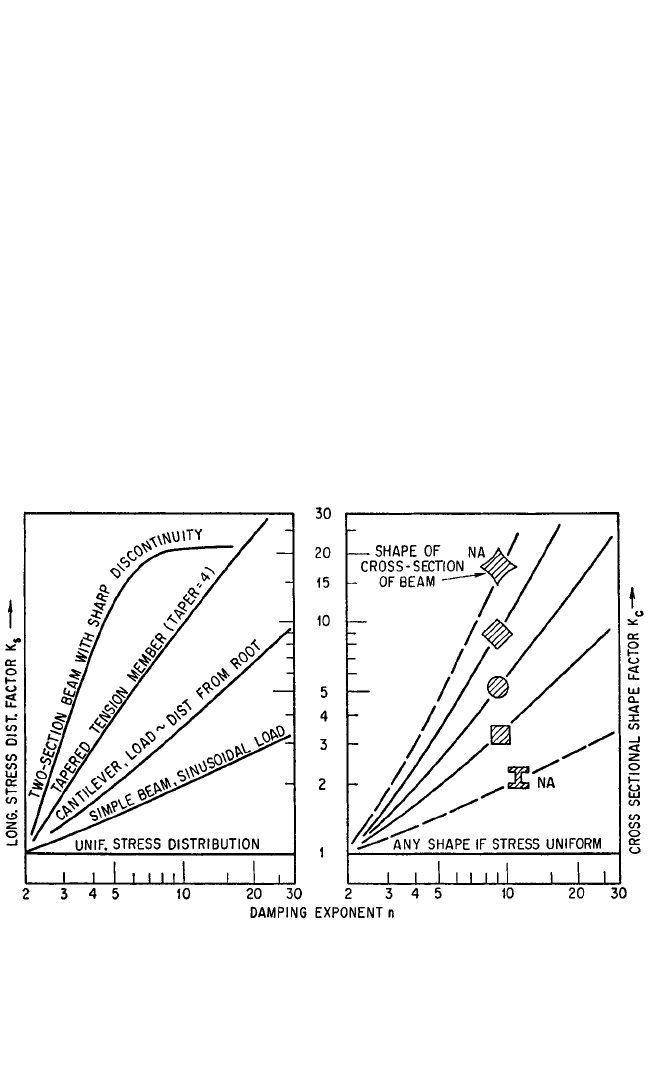
for a material and stress region for which the damping exponent n = 2.4 (characteris-
tic of metals at low and intermediate stress), the value of β/α shown in Table 36.1
varies from 1 for a tension-compression member to 1.6 for a rectangular beam with
quadratic moment distribution. If n = 8 (characteristic of materials at high stress), the
variation is from 1 to 10, and larger for beams with a higher stress gradient.
It is possible, for a variety of types of beams, to separate the ratio β/α into two fac-
tors:
12
(1) a cross-sectional shape factor K
c
which quantitatively expresses the effect of
stress distribution on a cross section, and (2) a longitudinal stress distribution factor K
s
which expresses the effect of stress distribution along the length of the beam. Then
= K
s
K
c
(36.18)
If material damping can be expressed as an exponential function of stress, as in Eq.
(36.9), some significant generalizations can be made regarding the pronounced
effect of the damping exponent n on each of these factors. Some of the results are
shown in Fig. 36.8 for beams of constant cross-section. These curves indicate that
high values of K
s
and K
c
are associated with a high damping exponent n, other fac-
tors being equal; K
c
is high when very little material is near peak stress. For example,
compare the diamond cross-section shape with the I beam, or compare the uniform
stress beam with the cantilever.
In much of the literature on damping, the existence of the factors α and β (or K
s
and K
c
) is not recognized; the unstated assumption is that α=β=1. As discussed
above, this assumption is true only for specimens under homogeneous stress.
β
α
MATERIAL DAMPING AND SLIP DAMPING 36.13
FIGURE 36.8 Effect of damping exponent n on longitudinal stress distribution factor and cross-
sectional shape factor of selected examples.
8434_Harris_36_b.qxd 09/20/2001 12:28 PM Page 36.13
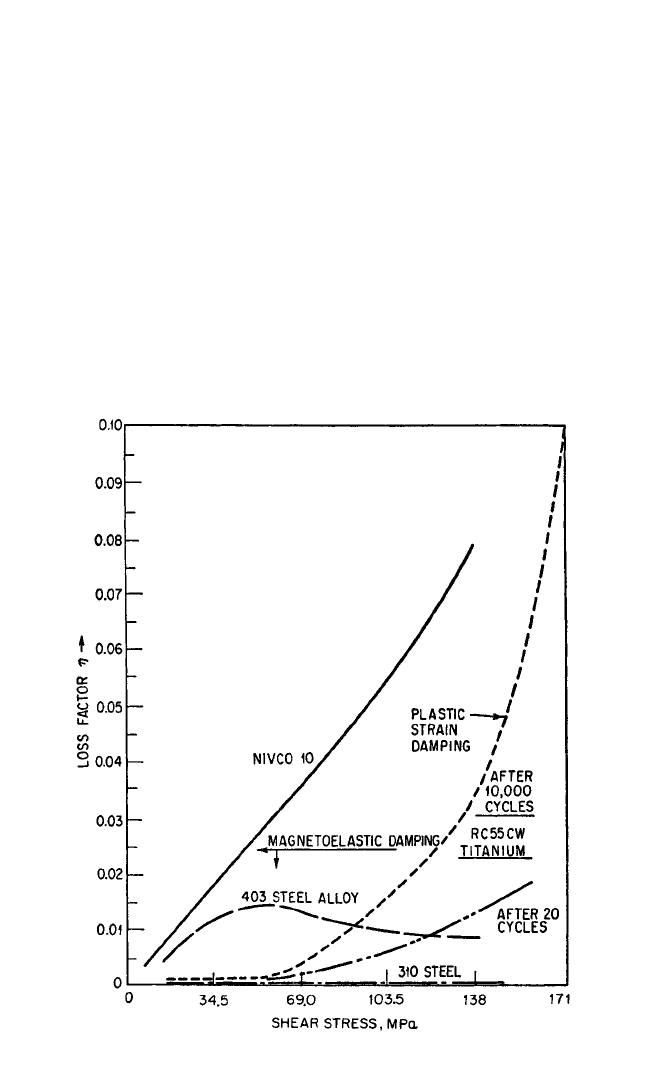
Relative damping units such as logarithmic decrement depend on the ratio of two
energies, the damping energy and the strain energy. Since strain energy increases
with the square of the stress for reasonably linear materials, the logarithmic decre-
ment remains constant with stress level and is independent of specimen shape and
stress distribution only for materials whose damping energy also increases as the
square of the stress [n = 2 in Eq. (36.9)]. For most materials at working stresses, n
varies between 2 and 3 (see Fig. 36.10), but for some (Fig. 36.9) it is highly variable.
In the high stress region, n lies in the range 8.0–20.0 (Fig. 36.10). In view of the broad
range of materials and stresses encountered in design, the case n = 2 must be
regarded as exceptional. Thus, logarithmic decrement is a variable rather than a
“material constant.” Its magnitude generally decreases significantly with stress
amplitude. When referring to specimens such as beams in which all stresses between
zero and some maximum stress occur simultaneously, the logarithmic decrement is
an ambiguous average value associated with some mean stress. Published data
require careful analysis before suitable comparisons can be made.
36.14 CHAPTER THIRTY-SIX
FIGURE 36.9 Comparison of internal friction and damping values for dif-
ferent inelastic mechanisms.
8434_Harris_36_b.qxd 09/20/2001 12:28 PM Page 36.14
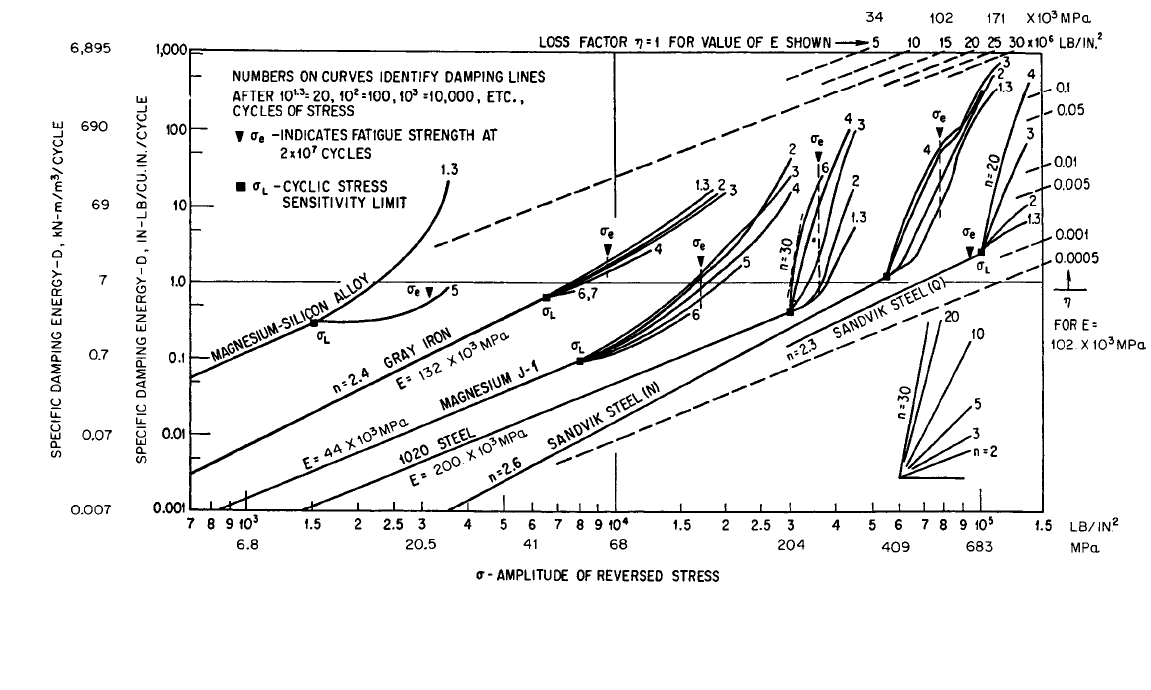
FIGURE 36.10 Specific damping energy of various materials as a function of amplitude of reversed
stress and number of fatigue cycles. Number of cycles is 10 to power indicated on curve. For example,
a curved marked 3 is for 10
3
or 1,000 cycles. Note: 6.895 kN⋅m/m
3
= 1 in.-lb/in.
3
and 1 MPa = 10
3
N/m
2
= 10
−3
kN/mm
2
= 146.5 lb/in.
2
.
36.15
8434_Harris_36_b.qxd 09/20/2001 12:28 PM Page 36.15

VISCOELASTIC MATERIALS
Some materials respond to load in a way that shows a pronounced influence of the
rate of loading. Generally the strain is larger if the stress varies slowly than it is if the
stress reaches its peak value swiftly. Among materials that exhibit this viscoelastic
behavior are high polymers and metals at elevated temperatures, as well as many
glasses, rubbers, and plastics.
13
As might be expected, these materials usually also
exhibit creep, an increasing deformation under constant applied load.
When a sinusoidal exciting force is applied to a viscoelastic solid, the strain is
observed to lag behind the stress. The phase angle between them, denoted by ϕ,is
the loss angle. The stress may be separated into two components, one in phase with
the strain and one leading it by a quarter cycle.The magnitudes of these components
depend upon the material and upon the exciting frequency, ω. For a specimen sub-
ject to homogeneous shear (α=β=1),
γ=γ
0
sin ωt (36.19)
σ=γ
0
[G′(ω) sin ωt + G″(ω) cos ωt] (36.20)
This is a linear viscoelastic stress-strain law.The theory of linear viscoelasticity is the
most thoroughly developed of viscoelastic theories. In Eq. (36.20), G′(ω) is known as
the “storage modulus in shear” and G″(ω) is the “loss modulus in shear” (the sym-
bols G
1
and G
2
are also widely used in the literature). The stiffness of the material
depends on G′ and the damping capacity on G″. In terms of these quantities the loss
angle ϕ=tan
−1
(G″/G′ ).The complex, or resultant, modulus in shear is G* = G′+iG″.
In questions of stress analysis, complex moduli have the advantage that the form of
Hooke’s law is the same as in the elastic case except that the elastic constants are
replaced by the corresponding complex moduli. Then a correspondence principle
often makes it possible to adapt an existing elastic solution to the viscoelastic case.
For details of viscoelastic stress analysis, see Ref. 31.
The moduli of linear viscoelasticity are readily related to the specific damping
energy D introduced previously. For a specimen in homogeneous shear of peak mag-
nitude γ
0
, the energy dissipated per cycle and per unit volume is
D =
2π/ω
0
σ
dt (36.21)
In view of Eqs. (36.19) and (36.20) this becomes
D =
2π/ω
0
γ
0
2
ω(G′ sin ωt + G″ cos ωt) cos ωt dt
=πγ
0
2
G″(ω) (36.22)
It is apparent from Eq. (36.22) that linear viscoelastic materials take the coefficient
n = 2 in Eq. (36.9). These materials differ from metals, however, by having damping
capacities that are strongly frequency- and temperature-sensitive.
1
DAMPING PROPERTIES OF MATERIALS
The specific damping energy D dissipated in a material exposed to cyclic stress is
affected by many factors. Some of the more important are:
dγ
dt
36.16 CHAPTER THIRTY-SIX
8434_Harris_36_b.qxd 09/20/2001 12:28 PM Page 36.16
